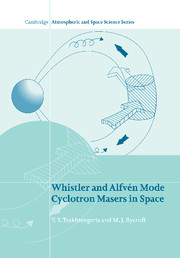Book contents
- Frontmatter
- Contents
- Preface
- Chapter 1 Introduction
- Chapter 2 Basic theory of cyclotron masers (CMs)
- Chapter 3 Linear theory of the cyclotron instability (CI)
- Chapter 4 Backward wave oscillator (BWO) regime in CMs
- Chapter 5 Nonlinear wave–particle interactions for a quasi-monochromatic wave
- Chapter 6 Nonlinear interaction of quasi-monochromatic whistler-mode waves with gyroresonant electrons in an inhomogeneous plasma
- Chapter 7 Wavelet amplification in an inhomogeneous plasma
- Chapter 8 Quasi-linear theory of cyclotron masers
- Chapter 9 Non-stationary CM generation regimes, and modulation effects
- Chapter 10 ELF/VLF noise-like emissions and electrons in the Earth's radiation belts
- Chapter 11 Generation of discrete ELF/VLF whistler-mode emissions
- Chapter 12 Cyclotron instability of the proton radiation belts
- Chapter 13 Cyclotron masers elsewhere in the solar system and in laboratory plasma devices
- Epilogue
- Systems of units, conversion factors and useful numerical values
- Glossary of terms
- Abbreviations and acronyms
- Bibliography
- Index
Chapter 4 - Backward wave oscillator (BWO) regime in CMs
Published online by Cambridge University Press: 02 May 2010
- Frontmatter
- Contents
- Preface
- Chapter 1 Introduction
- Chapter 2 Basic theory of cyclotron masers (CMs)
- Chapter 3 Linear theory of the cyclotron instability (CI)
- Chapter 4 Backward wave oscillator (BWO) regime in CMs
- Chapter 5 Nonlinear wave–particle interactions for a quasi-monochromatic wave
- Chapter 6 Nonlinear interaction of quasi-monochromatic whistler-mode waves with gyroresonant electrons in an inhomogeneous plasma
- Chapter 7 Wavelet amplification in an inhomogeneous plasma
- Chapter 8 Quasi-linear theory of cyclotron masers
- Chapter 9 Non-stationary CM generation regimes, and modulation effects
- Chapter 10 ELF/VLF noise-like emissions and electrons in the Earth's radiation belts
- Chapter 11 Generation of discrete ELF/VLF whistler-mode emissions
- Chapter 12 Cyclotron instability of the proton radiation belts
- Chapter 13 Cyclotron masers elsewhere in the solar system and in laboratory plasma devices
- Epilogue
- Systems of units, conversion factors and useful numerical values
- Glossary of terms
- Abbreviations and acronyms
- Bibliography
- Index
Summary
The purpose of this chapter is:
■ to explain how a backward wave oscillator (BWO) operates, from both a physical and a mathematical viewpoint;
■ to demonstrate that a BWO cannot work with a smooth distribution;
■ to estimate the minimum length of the generator region for the threshold condition to be met;
■ to find the temporal growth rate for a step distribution and for a beam distribution; and
■ to consider the effect of magnetic field inhomogeneity, e.g. as occurs along a geomagnetic flux tube.
The BWO generation regime is well-known in electronic devices, where wave generation is due to the interaction of a well-organized electron beam with man-made electrodynamic systems or with the external magnetic field (Johnson, 1955; Shevchik and Trubetskov, 1975; Wachtel and Wachtel, 1980; Ginzburg and Kuznetsov, 1981). The positive feedback inherent in such devices is due to the volume interaction of a ‘beam’ wave with an electromagnetic wave, the group velocities of the two interacting waves being in opposite directions. Thus, the absolute instability in the BWO generation regime does not need wave reflecting mirrors, and can be realized in length-limited systems. Such a regime is very attractive in space plasmas with their tremendous dimensions but may seem to be improbable there due to the need for having a well-organized charged particle beam. However, it turns out that such a ‘beam’ wave is not a rare phenomenon in space because that can appear on the step-like deformation of the distribution function (see Section 3.3).
- Type
- Chapter
- Information
- Whistler and Alfvén Mode Cyclotron Masers in Space , pp. 52 - 62Publisher: Cambridge University PressPrint publication year: 2008

